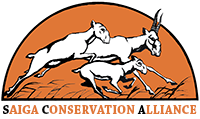In September 2022 SCA received a funding request from The Ukrainian Nature Conservation Group (UNCG) to provide funds to Askania Nova Biosphere Reserve in the Russian occupied province of Kherson, S.E Ukraine. Home to c.600 saigas.
In peace times UNCG aims to consolidate efforts of experts and scientists to protect Biodiversity and support the network of Protected Areas in Ukraine. Since Russia’s invasion of Ukraine the organisation has been working to limit the impact on ecosystems and biodiversity caused by war. What the New Kyiv Post have called ‘ecocide’.
Saiga Conservation Alliance has made two grants for fuel for anti poaching patrols and scientific monitoring of saiga in Askania Nova Biosphere Reserve.
In this blog we explain the recent history of Siaga in Ukraine and why protecting Askania Nova Biosphere Reserve’s saigas is important.

A History of Saiga Conservation in Ukraine
Originally saigas inhabited extensively large territories of the steppe from the Carpathian Mountains (E.Ukraine/Slovakia/Romania) through Dzhungaria (NW.China) and into Mongolia. Currently saigas occur only in Kazakhstan and Uzbekistan, Turkmenistan, Russia (Kalmykia and the Astrakhan province) with an isolated subspecies in Mongolia. This historic range included the Kherson province of SW.Ukraine, where virgin steppe and wetlands border the black sea. Saiga in Ukraine became extirpated (locally extinct) in the mid 18th century.
In the late 1880s Friedrich J.E Falz-Fein established the Askania Nova Reserve. A wildlife area the size of San Diego or Isle of Man, awarded UNESCO Biosphere status in 1983. Around this time Falz-Fein translocated saiga to Askania Nova in an attempt to establish a new population in Ukraine, by the 1920s again became locally extinct.
Another relocation of c.70 saigas from Kazakhstan in 1979 was much more successful, as Askania Nova now boasts a population of over 700.
Askania Nova biosphere reserve as recognised by UNESCO is an important habitat wildlife area that demonstrates a balanced relationship between people and nature. Saiga range across a protected area within the biosphere playing a vital ecological and cultural role for the people of Kherson and Ukraine.


Instability and conflict have lead to concern for Askania Nova’s saigas
In February 2022, the Russian invasion of Ukraine brought instability to Kherson province and Askania Nova biosphere reserve. This invasion disrupts both the Reserve’s work and wildlife’s quality of life. With the proximity to Black Sea, Russians occupied the region, making it dangerous for local people and wildlife. In July 2022, Russian forces seized some territory bordering Askania Nova, and the passage of tanks and armoured vehicles through the biosphere reserve tore up the landscape. Staff and wildlife are also forced to endure the thunderous threat of combat aircraft and missiles flying low overhead.
With Ukraine’s government occupied by fighting the invasion Askania Nova Biosphere reserve has lost c.$2.1 million in national funding. Banked funds are low, funds needed to maintain water holes (artesian wells) and supplementary feeds, for equipment upkeep, animal feed, and electricity. Even if government funds were available money would not be transferred into Russian occupied territory due to the risk of interception and fraud.
Reserve Staff have been threatened and buildings have been looted or occupied. There is a real fear of poacing and also excess death due to lack of grazing or water. However, thanks to the rangers ability to continue patrolling and monitoring, no cases of saiga poaching has been reported by UNCG or Askania Nova Biosphere Reserve.
Oleksii Vasyliuk, of UNCG, said he had not personally heard reports of poaching in his nation’s nature preserves but remained concerned about the animals. Herds of herbivores, including endangered saiga antelopes and Przewalski’s horses, roam in the Askania-Nova preserve, which is currently occupied by Russian forces.
In an interview with New York Times, April 2022
Thankfully, recent message tell us the situation remains the same. We are pleased that Askania Nova’s saigas play a vital ecological and cultural role for the people of Kherson and Ukraine and wish them luck for the upcoming birthing season.
